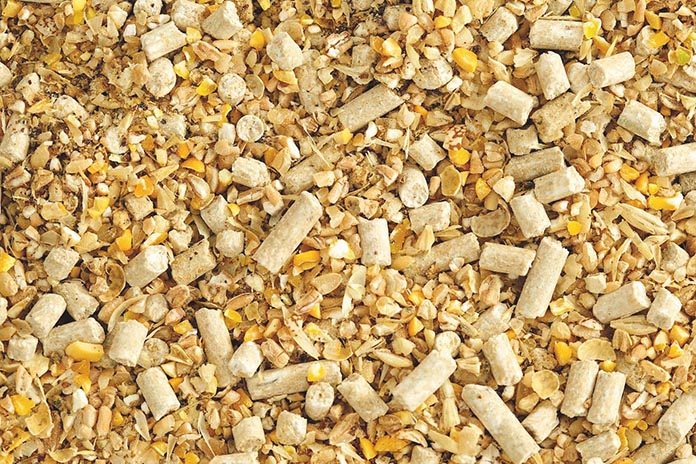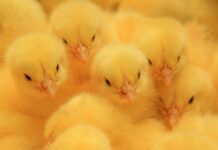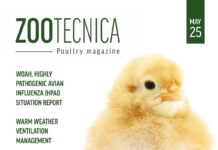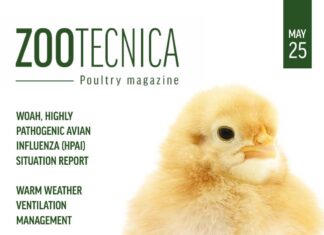
The transition towards low protein diets has been a gradual process of evolution rather than an epiphany moment and the history goes back to the early 1990’s. This paper will highlight the challenges faced in amino acid supply in commercial broiler diets in the UK currently and the future issues arising from environmental and commercial concerns.
The move towards low protein diets in the UK has been driven by several factors over the last 20 years or so. In the early 1990’s the transition was made to formulating using digestible amino acids rather than total; this immediately gave a reduction in protein content and was, in hindsight, a useful cost reduction and performance improving step. By 1996, though, the challenges became apparent with the voluntary removal of meat-and-bone meal, ahead of the total ban implemented by the EU in 2000, which included all ruminant derived products. Overnight, the feeding of broilers was constrained to mainly wheat/soya rations with some fish meal in the early diets. Quickly, consumer preferences were noted and many retailers required “vegetarian” diets thereby excluding fish meal, tallow and poultry offal meals. In 1999, the industry voluntarily withdrew antibiotic growth promotors from feed prior to the EU wide ban in 2006. Whilst this did not necessarily affect protein nutrition, it became evident that nutritional management to improve litter quality would influence our approach to overall crude protein levels. There is now a requirement to cease use of therapeutic antibiotics except where there is a clearly defined clinical need, which adds weight to this aspect. Since 2012, antibiotic use has reduced by 71% (BPC, 2017) and one of the primary uses of antibiotic was to treat enteric issues causing wet litter.
The level and source of proteins has an effect on intestinal Campylobacter perfringens populations with high or excess protein associated with greater incidence of necrotic enteritis or bacterial imbalance leading to enteritis and hence wet litter. Excess protein diets increase water consumption; Larbier and Leclercq (1994) estimated that 1% excess protein increases water intake by 3% in broilers. Since wet litter leads to higher incidence of pododermatitis, the avoidance of any increase in water use is regarded as essential. Trial work by Aviagen and reported by Kenny et al. (2010), that increased levels of balanced protein diets, led to poorer foot pad status confirms practical experience. Environmental issues have also played a role in shaping our application of protein nutrition. In 1996, the Integrated Pollution Prevention and Control Directive (IPPC) was drafted and came into force in 1999. This requires poultry, and pig, producers to use diets with reducing protein content and the monitoring of ammonia emissions as well as recording the nitrogen content of manures disposed of (IPPC Technical Guidance Note 2010). Wider global environmental concerns are also beginning to play a role in how we formulate diets. There is a desire in some sectors to reduce our reliance on imported soya bean meal as the main protein source in our feeds and, consequently where possible, the inclusion in feeds of some EU produced vegetable proteins are preferred by major retailers.
Ideal protein diets
The concept of formulating diets to achieve an ideal protein (IP) profile also referred to as balanced protein, is nothing new, and there are a selection of published profiles to choose from. Some cover the entire life of a commercial broiler whilst others are age specific. With the availability of feed grade amino acids, achieving the chosen profile should be feasible. However, the economics of feed formulation mean that some of the target values are aspirational rather than practical, particularly when high digestible lysine diets are used. In particular arginine, valine and isoleucine can be challenging in typical UK diets where, apart from soya bean meal and rapeseed/rapeseed meal, the other proteins available are typically field beans, maize gluten meal and fishmeal where permitted. The use of L-Valine is common practice and the addition of guanidinoacetic acid for its arginine sparing effect is increasing. However, the use of L-isoleucine, L-cystine or combined branched chain amino acids has yet to gain traction due to the current cost of these potential ingredients and lack of approved fermentation production methods to meet EU regulations. The prospect of increased reliance on supplemental amino acids was considered by Selle et al. (2015) and the use of free amino acids as energy sources for the gut mucosa rather than the intended purpose of protein accretion is a potential concern. Commercially, the boundaries are being tested and total supplemental amino acid additions of greater than 10 kg/t seem to give growth and FCR gains. With the application of IP and use of added amino acids, it is possible to increase growth rates and lower feed conversion as well as manipulate carcass yield. There is a diminishing return at farm level, as shown by Kemp et al. (2005) who demonstrated that increasing IP to 120% of control diet improved weight gain and FCR, but the economic return did not justify this approach at that time at farm level although processing margins were improved; perhaps indicating a mismatch between the economics of agriculture and processing. In a review presented by Ajinomoto (2015), it is proposed that reducing dietary crude protein by 1% gives a 7-10% reduction in N excretion. It is also shown that, using supplemental methionine, lysine, threonine and valine, the crude protein levels in a 1.05% digestible lysine diet can be reduced by 2.9% units in both maize and wheat based diets. Using supplemental amino acids to reduce crude protein has been reported by Dozier and Kidd (2014) in 29 to 40 day broilers where additions of lysine, methionine and threonine were used to maintain an IP profile where digestible lysine was 1.00%. This is not a particularly challenging level but weight gain and FCR were maintained along with carcass and breast yields.
How low can we go?
There seems to be considerable scope for reducing crude protein levels in broiler grower and finisher diets and making use of supplemental amino acids. In a trial conducted by van Harn and van Krimpen (2016), broiler grower and finisher diets were reduced in crude protein content by 1, 2 and 3% from control levels of 20.8 and 19.8% protein diets for the grower and finisher rations respectively. The digestible lysine levels were 1.05% and 0.99% for the control diets, not quite at commercial levels. The IP profile was maintained by the addition of amino acids: L-lysine HCl, DL-methionine, L-threonine, L-arginine, L-valine, L- isoleucine, tryptophan and L-glycine. The results are encouraging; for 0-35 day performance there was no effect on live weight and significant improvement (P<0.05) in FCR at -2% and -3% crude protein. Water intake was reduced numerically and foot pad scores were significantly (P<0.05) reduced at all protein reductions and litter condition scores were also improved in terms of friability and dryness.
Carcass characteristics showed a slight reduction in breast meat yield at -3% crude protein although carcass weight and yield were unaffected. However, the economic results showed that the cost of adding amino acids gave lower margins per bird of between -€0.024 and -€0.061 per bird. The other aspect reported was that reliance on amino acids has a negative impact on carbon foot print due to energy use in their production. In this trial, the g CO2-eq/kg is estimated to have increased from 725 to 875 g CO2-eq/kg live weight.
From a practical or commercial perspective, a number of amino acids that were used are not commercially available or permitted under EU legislation as feed ingredients. It does, though, indicate that there is scope if the materials are available.
As steps are taken to reduce crude protein diets, it is becoming appropriate to consider the supply of non-essential amino acids that we have taken for granted as being supplied in sufficient quantity with the allegedly surplus protein. The importance of considering glycine and serine in low protein diets was discussed by Siegert and Rodehutscord (2015), where the proteins in the chicken body incorporating both glycine and serine and the metabolic processes requiring adequate supplies of these amino acids are highlighted. In a situation of no antibiotic growth promotors and reduced therapeutic antibiotic use, we need to rethink the importance of individual amino acids and their role in maintaining gut health. In particular, mucin production is of relevance because it aids in protecting the gut mucosa and is dependent upon adequate glycine and serine. Siegert and Rodehutscord (2015) emphasised the importance of interrelationships between essential and non-essential amino acids and the need to consider increasing proportions of, for example, threonine as a precursor for the synthesis of glycine. It is also pointed out that, as commercial nutritionists are tempted to use higher levels of DL-methionine to maintain IP profiles, there is the factor of the role of glycine in the conversion of methionine to cysteine and in diets with low cysteine the requirement for glycine may be increased.
The conclusion drawn is that, with dietary protein concentrations below 20%, glycine and serine will become limiting and that a glycine equivalent value will be required for diet formulation is an indicator of future direction for feed formulation. A glycine equivalent value (Glyequi %) is calculated by glycine % + (0.7143 x serine %) where 0.7143 is the ratio of the molecular weights between glycine and serine, Kidd and Tillman (2016). The same authors note that the determination of digestible glycine and serine is difficult, but fortunately more work is being conducted in this area. The Glyequi requirement varies according to threonine level, and methionine to total sulphur amino acid ratio, according to Siegert and Rodehutscord (2015), values of 19.0 to 25.0 g/kg dry matter are needed to maximise gain to feed and average daily gain in 7 to 21 day broilers. This is seemingly qualified by Siegert et al. (2015) where a number of trials were used in a meta-analysis and it appears that, if there is adequate cysteine in the diet, then requirement for Glyequi is reduced and crude protein reductions might be feasible. Clearly, with the inability to use meat and bone meal, achievement of lower crude protein diets and maintaining supply of these “non-essential” amino acids will be challenging, unless feed grade sources become available and approved.
Reducing soybean use
Europe relies on imported soya bean meal to provide the majority of protein in monogastric feeds and takes this from the USA and South America. For a number of reasons, there is growing interest in reducing the reliance on this imported protein and increasing the use of locally sourced protein diets materials. Part of the justification is to improve food security and reduce trade deficits but, amongst retailers, the ability to use soya bean in the food supply chain that is not derived from genetically modified (GM) seed stocks is a key objective. As the acreage of GM derived soya crops increases, it is becoming harder to source non GM meal through a supply chain that handles both GM and non GM material.
Alternative protein sources available within Europe do not have the amino acid content or digestibility of soya bean meal and therefore any substitution of soya is going to increase crude protein diets levels if amino acid specifications are to be maintained. Much interest has been shown in using legumes, either field beans or peas, with retailer sponsored trials conducted for pig and poultry on commercial units. These have been successful to the point of confirming that they can be used but the substitution of soybean is limited for a number of reasons.
This simplistic approach does, though, illustrate that replacing 1% soya bean meal in a ration is going to require considerably more than 1% of an alternative protein meal. This then creates cost in the formulation process through lack of space. The legumes can be used at sensible levels, 12% for beans and 20% for peas would be considered acceptable if they were available in sufficient quantity and of the right quality. The lack of supply means that consistent availability is a problem for feed mills. Field mycotoxin contamination is a concern for beans being harvested late in the season and often subject to rain. Whole rapeseed is used to maximal levels but maintaining pellet quality tends to limit use to about 12%; sunflower is rarely economic. Heat processed blends of whole rapeseed plus beans or peas are widely used and can reach levels of 20% in diets but, again, pellet quality can become an issue and more typical inclusions are 10-15%.
There is much publicity about the use of insect protein for feeds in Europe with pilot plants producing meal from predominately dried Black Soldier Fly larvae. The review by Leek (2016) highlights the potential for insect sources to provide material suitable for aqua-culture and pet feeds, before poultry feeds, purely on a cost basis although the oil extracted from the dried larvae may find value in monogastric feeds. Although approved for use in fish feed, legislation does not yet allow insect proteins to be included in other feeds and it is likely to be some considerable time before it does. Then there are the issues of cost, scale of production and substrate selection for producing insects on. Analysis data shown by Leek (2016) illustrates potential difficulties arising from high calcium content of black soldier fly larvae and the variability of analysis including amino acids and fatty acid profile dependant on the substrate used. It is not realistic to suggest that current UK broiler chicken diets are notably lower in protein than those used elsewhere. However, there is pressure from a number of areas to reduce crude protein whilst maintaining diet performance levels. Environmental controls are guiding farmers towards using lower protein diets and cost efficiency is clearly a major factor in maximising the efficient use of protein. As these take effect, we need to secure materials, which will support attainment of appropriate IP, taking account of the 4th, 5th and 6th limiting amino acids as well as the clearly important role of some non-essential amino acids which are becoming obligatory.
In the face of these challenges, there is the consumer driven need to seek alternative protein sources to soya bean meal, which so far has the potential effect of increasing crude protein levels in diets.
References are available on request
From the Proceedings of the 2018 Australian Poultry Science Symposium

















